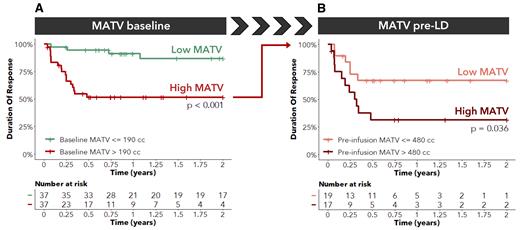Introduction
CD19-targeted chimeric antigen receptor (CAR) T-cell therapy has become the standard 2 nd or 3 rd line therapy for patients with relapsed or refractory Large B-cell lymphoma (r/r LBCL). As part of this treatment bridging therapy is frequently used between T-cell apheresis and CAR T-cell infusion in order to limit disease progression, diminish lymphoma-related symptoms and/or reduce tumor volume. Bridging therapy has shown to be feasible, safe and effective in patients prior to infusion. In addition, a lower tumor volume is associated with better treatment outcomes and less toxicity. However, the exact reduction and dynamics in metabolic active tumor volume (MATV) are unknown. Here we investigated the relation of changes in pre-apheresis (baseline) MATV, based on 18F-FDG PET scans, and pre-lymphodepleting chemotherapy (pre-LD) MATV with CAR T-cell outcomes and toxicities in patients with r/r LBCL.
Methods
Baseline and pre-LD MATVs and PET characteristics were calculated semi-automatically of patients who were treated with CAR T-cell therapy. A Standardized Uptake Value (SUV) threshold of 2.5 was used to maintain robustness and avoid MATV underestimation. Bridging strategies consisted of radiotherapy, chemotherapy, or a combination of both. Primary endpoints were duration of response (DOR) and overall survival (OS). Secondary endpoints included cytokine release syndrome (CRS) and immune effector cell-associated neurotoxicity syndrome (ICANS). The Youden index was used to identify the optimal cut-off for dividing patients into low- and high-MATV groups to predict DOR at 2 years. Two-year DOR and OS rates were estimated using Kaplan-Meier curves and the log-rank test was utilized to compare the differences among low- and high-MATV patient groups. Univariable analysis was performed with Cox regression for DOR and OS, and with logistic regression for CRS and ICANS.
Results
Seventy-four patients with LBCL and treated with CAR T-cell therapy were included in the study. For all patients baseline 18F-FDG PET scans were available, whereof in 68 patients the pre-LD scans. The median baseline MATV was 180 cc (IQR 64 - 426) with a median SUV max of 18.8 (IQR 11.9 - 28.1) and increased to 241 cc (IQR 75 - 525) at pre-LD, with a median SUV max of 21.0 (IQR 12.8 - 31.3).
The optimal cut-offs for low- and high-MATV patient groups at baseline and pre-LD were 190 cc and 480 cc, respectively. Patients with a low MATV baseline had a better DOR (Figure 1A) and OS compared to high MATV baseline patients (both p < 0.001). Patients with a high MATV baseline that was reduced to a low MATV pre-LD showed a significant improvement in DOR (Figure 1B) and OS, compared to patients with a high MATV pre-LD ( p = 0.036 for DOR; p = 0.015 for OS).
Univariable analysis showed that a high baseline MATV was associated with a worse DOR (HR 6.43 CI [2.15 - 19.20]; p < 0.001) and OS (HR 6.97 CI [2.33 - 20.80]; p < 0.001). A high pre-LD MATV was also associated with a worse DOR (HR 4.86 CI [1.98 - 12.00]; p < 0.001) and OS (HR 5.87 [2.41 - 14.30]; p < 0.001). Other significant associations with DOR and OS were observed for pre-LD lactate dehydrogenase (LDH), the IPI score for DOR exclusively, and gender and bridging therapy for OS exclusively.
Conclusions
We showed that patients with a low MATV compared to a high MATV at baseline have better survival outcomes and less toxicity. Additionally, reducing tumor volume by applying bridging therapy in patients with a high baseline MATV, results in a significant better DOR and OS. Reducing the MATV before CAR T-cell infusion is therefore essential in CAR T-cell therapy patient care and provides a rationale for the use of more intensive bridging therapies.
Disclosures
No relevant conflicts of interest to declare.


This feature is available to Subscribers Only
Sign In or Create an Account Close Modal